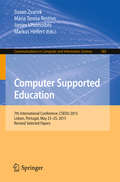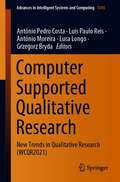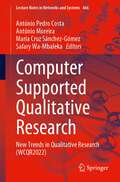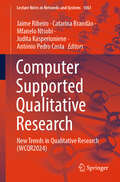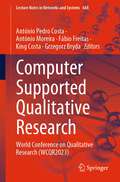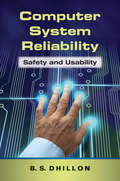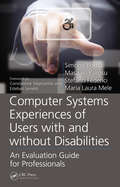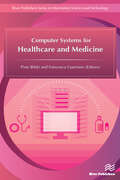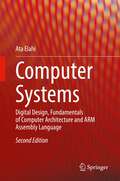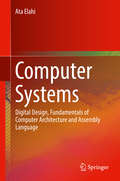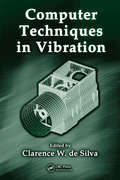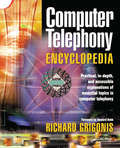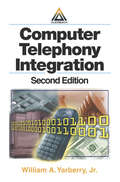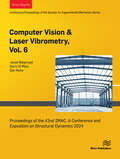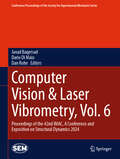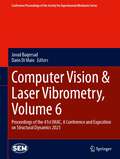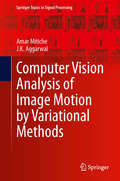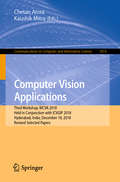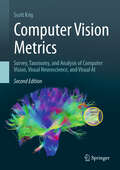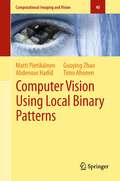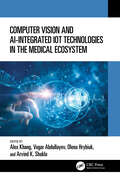- Table View
- List View
Computer Supported Education: 7th International Conference, CSEDU 2015, Lisbon, Portugal, May 23-25, 2015, Revised Selected Papers (Communications in Computer and Information Science #583)
by Susan Zvacek Markus Helfert Maria Teresa Restivo James UhomoibhiThis book constitutes the refereed proceedings of the 6th International Conference on Computer Supported Education, CSEDU 2014, held in Barcelona, Spain, in April 2014. The 24 revised full papers presented were carefully reviewed and selected from 242 submissions. The papers address topics such as information technologies supporting learning; learning/teaching methodologies and assessment; social context and learning environments; domain applications and case studies; and ubiquitous learning.
Computer Supported Qualitative Research: New Trends in Qualitative Research (WCQR2021) (Advances in Intelligent Systems and Computing #1345)
by António Moreira Luís Paulo Reis Luca Longo António Pedro Costa Grzegorz BrydaThis book includes selecting the articles accepted for presentation and discussion at WCQR2021, held on January 20th to 22nd, 2021 (Virtual Conference). The World Conference on Qualitative Research (WCQR) is an annual event that aims to bring together researchers, academics and professionals, promoting the sharing and discussion of knowledge, new perspectives, experiences and innovations on Qualitative Research. WCQR2021 featured four main application fields (Education, Health, Social Sciences, and Engineering/Technology) and seven main subjects: Rationale and Paradigms of Qualitative Research; Systematization of Approaches with Qualitative Studies; Qualitative and Mixed Methods Research; Data Analysis Types; Innovative Processes of Qualitative Data Analysis; Qualitative Research in Web Context; Qualitative Analysis with Software Support. The book is a valuable resource for everyone interested in qualitative research, emphasizing Computer-Assisted Qualitative Data Analysis Software (CAQDAS).
Computer Supported Qualitative Research: New Trends in Qualitative Research (WCQR2022) (Lecture Notes in Networks and Systems #466)
by António Moreira António Pedro Costa Safary Wa-Mbaleka Maria Cruz Sánchez‑GómezThis book includes selecting the articles accepted for presentation and discussion at WCQR2022, held on January 26 to 28, 2022 (Virtual Conference). The World Conference on Qualitative Research (WCQR) is an annual event that aims to bring together researchers, academics and professionals, promoting the sharing and discussion of knowledge, new perspectives, experiences and innovations on qualitative research. WCQR2022 featured four main application fields (education, health, social sciences, and engineering/technology) and seven main subjects: Rationale and paradigms of qualitative research; systematization of approaches with qualitative studies; qualitative and mixed methods research; data analysis types; innovative processes of qualitative data analysis; qualitative research in Web context; and qualitative analysis with software support. The book is a valuable resource for everyone interested in qualitative research, emphasizing computer-assisted qualitative data analysis software (CAQDAS).
Computer Supported Qualitative Research: New Trends in Qualitative Research (WCQR2024) (Lecture Notes in Networks and Systems #1061)
by António Pedro Costa Jaime Ribeiro Catarina Brandão Mfanelo Ntsobi Judita KasperiunieneThis book aims to bring together researchers, academics, and professionals, promoting the sharing and discussing knowledge, new perspectives, experiences, and innovations in Qualitative Research. This book includes selecting the articles accepted for presentation and discussion at WCQR2024, held January 23 to 25, 2024 (face-to-face and virtual conference). WCQR2024 featured four main application fields (Education, Health, Social Sciences, and Engineering/Technology) and seven main subjects: Rationale and Paradigms of Qualitative Research; Systematization of Approaches with Qualitative Studies; Qualitative and Mixed Methods Research; Data Analysis Types; Innovative Processes of Qualitative Data Analysis; Qualitative Research in Web Context; Qualitative Analysis with Software Support. The book is valuable for everyone interested in qualitative research, emphasizing Computer-Assisted Qualitative Data Analysis Software (CAQDAS).
Computer Supported Qualitative Research: New Trends on Qualitative Research (WCQR2019) (Advances in Intelligent Systems and Computing #1068)
by António Moreira Luís Paulo Reis António Pedro CostaThe World Conference on Qualitative Research (WCQR) is an annual event that aims to bring together researchers, academics and professionals, promoting the sharing and discussion of knowledge, new perspectives, experiences and innovations on the field of Qualitative Research. This book includes a selection of the articles accepted for presentation and discussion at WCQR2019, held in Porto, Portugal, October 16-18, 2019. WCQR2019 featured four main application fields (Education, Health, Social Sciences, and Engineering/Technology) and seven main subjects: Rationale and Paradigms of Qualitative Research; Systematization of Approaches with Qualitative Studies; Qualitative and Mixed Methods Research; Data Analysis Types; Innovative Processes of Qualitative Data Analysis; Qualitative Research in Web Context; Qualitative Analysis with Software Support. The book is a valuable resource for everyone interested in Qualitative Research with emphasis on Computer Assisted Qualitative Data Analysis.
Computer Supported Qualitative Research: World Conference on Qualitative Research (WCQR2023) (Lecture Notes in Networks and Systems #688)
by António Moreira António Pedro Costa Grzegorz Bryda Fábio Freitas King CostaThis book includes selecting the articles accepted for presentation and discussion at WCQR2023, held from January 25 to 27, 2023 (face to face and virtual conference). The World Conference on Qualitative Research (WCQR) is an annual event that aims to bring together researchers, academics and professionals, promoting the sharing and discussing knowledge, new perspectives, experiences and innovations in qualitative research. WCQR2023 featured four main application fields (education, health, social sciences and engineering/technology) and seven main subjects: rationale and paradigms of qualitative research; systematization of approaches with qualitative studies; qualitative and mixed methods research; data analysis types; innovative processes of qualitative data analysis; qualitative research in web context; and qualitative analysis with software support. The book is valuable for everyone interested in qualitative research, emphasizing Computer-Assisted Qualitative Data Analysis Software (CAQDAS).
Computer System Reliability: Safety and Usability
by B.S. DhillonComputer systems have become an important element of the world economy, with billions of dollars spent each year on development, manufacture, operation, and maintenance. Combining coverage of computer system reliability, safety, usability, and other related topics into a single volume, Computer System Reliability: Safety and Usability eliminates th
Computer Systems Engineering Management: Electrical Engineering And Electronics, 45
by Robert S. AlfordComputer Systems Engineering Management provides a superb guide to the overall effort of computer systemsbridge building. It explains what to do before you get to the river, how to organise your work force, how to manage the construction, and what do when you finally reach the opposite shore. It delineates practical approaches to real-world development issues and problems presents many examples and case histories and explains techniques that apply to everything from microprocessors to mainframes and from person computer applications to extremely sophisticated systems
Computer Systems Experiences of Users with and Without Disabilities: An Evaluation Guide for Professionals (Rehabilitation Science in Practice Series)
by Masaaki Kurosu Stefano Federici Simone Borsci Maria Laura MeleThis book provides to manufacturers, designers and evaluation professionals the necessary tools for balancing design and the assessment phases during the product lifecycle. It proposes an integrated model of interaction evaluation for a holistic analysis of the user experience by both discussing in details the interaction testing methods, and promoting the involvement of disabled users in human computer interaction evaluation.
Computer Systems for Healthcare and Medicine (River Publishers Series In Information Science And Technology Ser.)
by Francesca Guerriero Piotr BilskiThe development of modern civilization leads to us having to solve new problems which did not exist before. The contemporary world faces a great challenge of aging societies, where the increasing number of citizens requires constant medical attention. To ensure safety and wellbeing of elderly people, patients in hospitals and disabled persons, advanced technologies can be implemented. These include both sophisticated data acquisition systems and data processing algorithms, aiming at the constant and discreet monitoring of persons whilst raising alarm if immediate attention is required.Computer Systems for Healthcare and Medicine presents a novel look at the introduced problems, including proposed solutions in the form of automated data acquisition and processing systems, which were tested in various environments. Characteristic features include a wide range of sensors used to monitor the situation of the person, and accurate decision making algorithms, often based on the computational intelligence domain. Technical topics discussed in the book include application for the healthcare of the following:Infrared sensorsMEMSUltra wideband radarsDeep learningDecision treesArtificial neural networksGabor filtersDecision support systems
Computer Systems for Occupational Safety and Health Management
by Charles W. RossThis book describes how safety and other professionals may use safety database software on a personal computer to manage their safety and health programs. It emphasizes the techniques and features necessary to develop a computerized safety data system for a personal computer.
Computer Systems: Digital Design, Fundamentals of Computer Architecture and ARM Assembly Language
by Ata ElahiThis updated textbook covers digital design, fundamentals of computer architecture, and ARM assembly language. The book starts by introducing computer abstraction, basic number systems, character coding, basic knowledge in digital design, and components of a computer. The book goes on to discuss information representation in computing, Boolean algebra and logic gates, and sequential logic. The book also presents introduction to computer architecture, Cache mapping methods, and virtual memory. The author also covers ARM architecture, ARM instructions, ARM assembly language using Keil development tools, and bitwise control structure using C and ARM assembly language. The book includes a set of laboratory experiments related to digital design using Logisim software and ARM assembly language programming using Keil development tools. In addition, each chapter features objectives, summaries, key terms, review questions, and problems.
Computer Systems: Digital Design, Fundamentals of Computer Architecture and Assembly Language
by Ata ElahiThis textbook covers digital design, fundamentals of computer architecture, and assembly language. The book starts by covering basic number systems and character coding, basic knowledge in digital design, and components of a computer. It goes on to cover topics such as information representation in computing; Boolean algebra and logic gates; sequential logic; input/output; and CPU performance. The author also covers ARM architecture, ARM instructions and ARM assembly language which is used in a variety of devices such as cell phones, digital TV, automobiles, routers, and switches. The book contains a set of laboratory experiments related to digital design using Logisim software; in addition, each chapter features objectives, summaries, key terms, review questions and problems. The book is targeted to students majoring Computer Science, Information System and IT and follows the ACM/IEEE 2013 guidelines. * Comprehensive textbook covering digital design, computer architecture, and ARM architecture and assembly * Covers basic number system and coding, basic knowledge in digital design, and components of a computer * Features laboratory exercises in addition to objectives, summaries, key terms, review questions, and problems in each chapter
Computer Techniques in Vibration
by Clarence W. de SilvaUnderstanding and controlling vibration is critical for reducing noise, improving work environments and product quality, and increasing the useful life of industrial machinery and other mechanical systems. Computer-based modeling and analytical tools provide fast, accurate, and efficient means of designing and controlling a system for improved vibr
Computer Telephony Encyclopedia
by Richard GrigonisIf you want to grasp the full length and breadth of the rapidly developing computer telephony field, this book is the place to start. Author Richard Grigonis thoroughly explains even the most abstruse ideas in a concise manner that is aimed at all kinds of readers -- students, business executives, telecom managers, call center supervisors or entrep
Computer Telephony Integration
by William A. Yarberry Jr.Since the publication of the first edition, the CTI world has changed significantly. Where it was once focused on the integration of voice systems with computers, the focus is now on IP-based voice, or converged networks and services. Today, the telcos are upgrading their systems from circuit-switched to IP-based packet-switched networks. Companies
Computer Vision & Laser Vibrometry, Vol. 6: Proceedings of the 42nd IMAC, A Conference and Exposition on Structural Dynamics 2024
by Dario Di Maio Javad Baqersad Dan RoheComputer Vision & Laser Vibrometry, Volume 6: Proceedings of the 42nd IMAC, A Conference and Exposition on Structural Dynamics, 2024, the sixth volume of ten from the Conference brings together contributions to this important area of research and engineering. The collection presents early findings and case studies on fundamental and applied aspects of Computer Vision, Laser Vibrometry and Structural Health Monitoring, including papers on: Novel Techniques Optical Methods, Scanning LDV Methods Photogrammetry & DIC Structural Health Monitoring.
Computer Vision & Laser Vibrometry, Vol. 6: Proceedings of the 42nd IMAC, A Conference and Exposition on Structural Dynamics 2024 (Conference Proceedings of the Society for Experimental Mechanics Series)
by Dario Di Maio Javad Baqersad Dan RoheComputer Vision & Laser Vibrometry, Volume 6: Proceedings of the 42nd IMAC, A Conference and Exposition on Structural Dynamics, 2024, the sixth volume of ten from the Conference brings together contributions to this important area of research and engineering. The collection presents early findings and case studies on fundamental and applied aspects of Computer Vision, Laser Vibrometry and Structural Health Monitoring, including papers on: Novel Techniques Optical Methods, Scanning LDV Methods Photogrammetry & DIC Structural Health Monitoring
Computer Vision & Laser Vibrometry, Volume 6: Proceedings of the 41st IMAC, A Conference and Exposition on Structural Dynamics 2023 (Conference Proceedings of the Society for Experimental Mechanics Series)
by Dario Di Maio Javad BaqersadComputer Vision & Laser Vibrometry, Volume 6: Proceedings of the 41st IMAC, A Conference and Exposition on Structural Dynamics, 2023, the sixth volume of ten from the Conference brings together contributions to this important area of research and engineering. The collection presents early findings and case studies on fundamental and applied aspects of Computer Vision, Laser Vibrometry and Structural Health Monitoring, including papers on:Novel TechniquesOptical Methods,Scanning LDV MethodsPhotogrammetry & DICStructural Health Monitoring
Computer Vision Analysis of Image Motion by Variational Methods (Springer Topics in Signal Processing #10)
by Amar Mitiche J. K. AggarwalThis book presents a unified view of image motion analysis under the variational framework. Variational methods, rooted in physics and mechanics, but appearing in many other domains, such as statistics, control, and computer vision, address a problem from an optimization standpoint, i.e., they formulate it as the optimization of an objective function or functional. The methods of image motion analysis described in this book use the calculus of variations to minimize (or maximize) an objective functional which transcribes all of the constraints that characterize the desired motion variables. The book addresses the four core subjects of motion analysis: Motion estimation, detection, tracking, and three-dimensional interpretation. Each topic is covered in a dedicated chapter. The presentation is prefaced by an introductory chapter which discusses the purpose of motion analysis. Further, a chapter is included which gives the basic tools and formulae related to curvature, Euler Lagrange equations, unconstrained descent optimization, and level sets, that the variational image motion processing methods use repeatedly in the book.
Computer Vision Applications: Third Workshop, WCVA 2018, Held in Conjunction with ICVGIP 2018, Hyderabad, India, December 18, 2018, Revised Selected Papers (Communications in Computer and Information Science #1019)
by Chetan Arora Kaushik MitraThis book constitutes the refereed proceedings of the third Workshop on Computer Vision Applications, WCVA 2018, held in Conjunction with ICVGIP 2018, in Hyderabad, India, in December 2018. The 10 revised full papers presented were carefully reviewed and selected from 32 submissions. The papers focus on computer vision; industrial applications; medical applications; and social applications.
Computer Vision Metrics: Survey, Taxonomy, and Analysis of Computer Vision, Visual Neuroscience, and Visual AI
by Scott KrigThis 2nd Edition, based on the successful 2016 textbook, has been updated and expanded to cover 3rd generation Computer Vision and AI as it supersedes historical visual computing methods, providing a comprehensive survey of essential topics and methods in Computer Vision. With over 1,200 essential references, as well as chapter-by-chapter learning assignments, the book offers a valuable resource for students, researchers, scientists and engineers, helping them dig deeper into core computer vision and foundational visual computing and neuroscience topics. As before, a historical survey of advances in Computer Vision is provided, updated to reflect the latest methods such as Vision Transformers, attention models, alternative features such as Fourier neurons and Binary neurons, hybrid DNN architectures, self-supervised and enhanced learning models, Associative Multimodal Learning, Continuous Learning, View Synthesis, intelligent Scientific Imaging, andadvances in training protocols. Updates have also been added for 2d/3d cameras, software libraries and open source resources, computer vision cloud services, and vision/AI hardware accelerators. Discussion and analysis are provided to uncover intuition and delve into the essence of key advancements, applied and forward-looking topics.
Computer Vision Systems: 12th International Conference, ICVS 2019, Thessaloniki, Greece, September 23–25, 2019, Proceedings (Lecture Notes in Computer Science #11754)
by Markus Vincze Dimitrios Tzovaras Dimitrios Giakoumis Antonis ArgyrosThis book constitutes the refereed proceedings of the 12th International Conference on Computer Vision Systems, ICVS 2019, held in Thessaloniki, Greece, in September 2019.The 72 papers presented were carefully reviewed and selected from 114 submissions. The papers are organized in the following topical sections; hardware accelerated and real time vision systems; robotic vision; vision systems applications; high-level and learning vision systems; cognitive vision systems; movement analytics and gesture recognition for human-machine collaboration in industry; cognitive and computer vision assisted systems for energy awareness and behavior analysis; and vision-enabled UAV and counter UAV technologies for surveillance and security of critical infrastructures.
Computer Vision Using Local Binary Patterns: Computer Vision Using Local Binary Patterns (Computational Imaging and Vision #40)
by Guoying Zhao Matti Pietikäinen Timo Ahonen Abdenour HadidThe recent emergence of Local Binary Patterns (LBP) has led to significant progress in applying texture methods to various computer vision problems and applications. The focus of this research has broadened from 2D textures to 3D textures and spatiotemporal (dynamic) textures. Also, where texture was once utilized for applications such as remote sensing, industrial inspection and biomedical image analysis, the introduction of LBP-based approaches have provided outstanding results in problems relating to face and activity analysis, with future scope for face and facial expression recognition, biometrics, visual surveillance and video analysis. Computer Vision Using Local Binary Patterns provides a detailed description of the LBP methods and their variants both in spatial and spatiotemporal domains. This comprehensive reference also provides an excellent overview as to how texture methods can be utilized for solving different kinds of computer vision and image analysis problems. Source codes of the basic LBP algorithms, demonstrations, some databases and a comprehensive LBP bibliography can be found from an accompanying web site. Topics include: local binary patterns and their variants in spatial and spatiotemporal domains, texture classification and segmentation, description of interest regions, applications in image retrieval and 3D recognition - Recognition and segmentation of dynamic textures, background subtraction, recognition of actions, face analysis using still images and image sequences, visual speech recognition and LBP in various applications. Written by pioneers of LBP, this book is an essential resource for researchers, professional engineers and graduate students in computer vision, image analysis and pattern recognition. The book will also be of interest to all those who work with specific applications of machine vision.
Computer Vision and AI-Integrated IoT Technologies in the Medical Ecosystem
by Alex Khang Vugar Abdullayev Olena Hrybiuk Arvind K. ShuklaThis book examines computer vision and IoT-integrated technologies used by medical professionals in decision-making, for sustainable development in a healthcare ecosystem, and to better serve patients and stakeholders. It looks at the methodologies, technologies, models, frameworks, and practices necessary to resolve the challenging issues associated with leveraging the emerging technologies driving the medical field.The chapters discuss machine vision, AI-driven computer vision, machine learning, deep learning, AI-integrated IoT technology, data science, blockchain, AR/VR technology, cloud data, and cybersecurity techniques in designing and implementing a smart healthcare infrastructure in the era of the Industrial Revolution 4.0. Techniques are applied to the detection, diagnosis, and monitoring of a wide range of health issues.Computer Vision and AI-Integrated IoT Technologies in the Medical Ecosystem targets a mixed audience of students, engineers, researchers, academics, and professionals who are researching and working in the field of medical and healthcare industries from different environments and countries.
